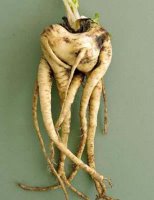A: Okay, you get points if you answered mushy peas, but the answer is actually the parsnip. The English eat more parsnips than any other nation; in fact, they can be hard to find elsewhere, and don't have a glittering reputation in the rest of the world. But the parsnip has a long and storied history. It is closely related to - but more nutritious than - the carrot, and references to its cultivation in the eastern Mediterranean appear in both Greek and Roman writings. (Interestingly, Britain is the only European country that consumes more carrots than potatoes per capita - but that's a topic for a different entry. Another day, another root vegetable, as they say.) Medieval Europeans valued parsnips for their supposed healing powers; they were thought to be efficacious for a number of intractable medical problems, including toothache, stomach pains and swollen testicles. Before the advent of the sugar beet in the nineteenth century, parsnips were used as a sweetener in both Europe and North America. But beware when foraging for parsnip in the wild; it is easily confused with the toxic and potentially fatal poison hemlock, another plant associated with the less salubrious side of ancient Greece.

Recently, a national contest recognized the frightful parsnip pictured here as the ugliest vegetable in Britain. The Guardian described it as "resembling a creature from the abyss."
Jane Grigson, in her classic English Food, declines to comment on the aesthetic qualities of the parsnip, but does issue a stern warning about its preparation. " 'PARSNIPS NEED BUTTER' should be inscribed in letters of fire in every kitchen," she writes. "Without butter, or an equivalent fat of quality (which does not mean margarine, but good beef dripping), they can be a depressing vegetable." This preparation uses olive oil, and is quite delicious; the bitterness of the salad leaves provides a beautiful contrast to the caramelized sweetness of the parsnips, and the chicken adds a salty, meaty layer of flavor.

Chicken, Parsnip and Potato Salad
1 teaspoon plus 2 tablespoons extra virgin olive oil
3 medium parsnips
2 small potatoes (preferably Yukon Gold)
6 cloves garlic
1/2 teaspoon dried thyme (not ground)
1 cup chopped cooked chicken
1 teaspoon white wine vinegar
Mixed greens with frisee
Preheat oven to 400° F (!)
Peel, quarter and core parsnips. Cut into French-fry-sized pieces. Peel potates and cut into 1-inch cubes. Leave garlic cloves whole. Toss parsnips, potatoes and garlic in 1 teaspoon olive oil with the thyme and plenty of salt and pepper. Roast, stirring occasionally, until golden brown and tender, about 40 minutes (but keep an eye on them; parsnips get too crunchy very easily).
If chicken is cold, add it to roasting pan about 5 minutes before vegetables are done to heat through.
Remove garlic cloves from roasting pan, and squeeze their pulp into a small bowl. Add remainder of olive oil, vinegar, salt and freshly ground pepper, and beat well.
Remove garlic cloves from roasting pan, and squeeze their pulp into a small bowl. Add remainder of olive oil, vinegar, salt and freshly ground pepper, and beat well.
Toss half of dressing with chicken/vegetable mixture, and the other half with mixed greens. Divide mixed greens among plates and top with chicken and vegetables. Serve with lots of crusty bread.
Serves 2 as a main course or 4 as a first course.
Adapted from a recipe by Celia Barbour, published in the New York Times on September 20, 2006




1 comment:
Oh, my! Parsnips. For some reason even he can't remember, my dad has always loved them (and he's from strictly German heritage - no English on his side). Mom always throws some in for him when she makes pot roast (one of my favorites my whole life) and even though I give them a taste every 10 years or so, I still think they're gross... I might like them your way, though, so I'll consider reconsidering. Maybe. Oh, my.
Post a Comment